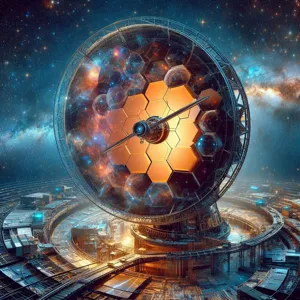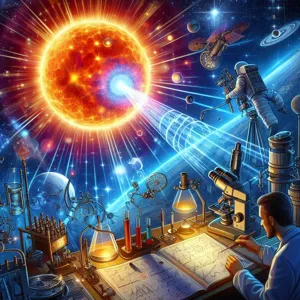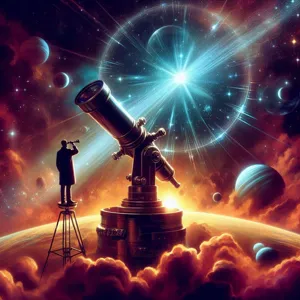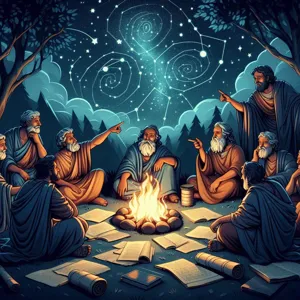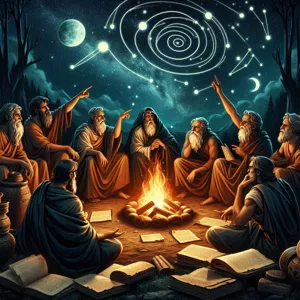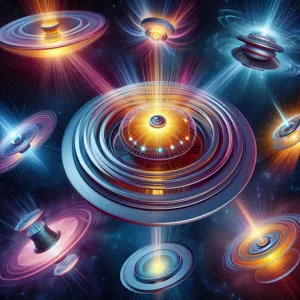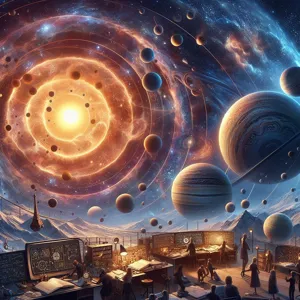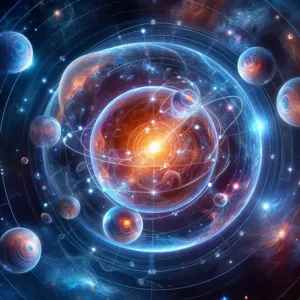The universe, with its vast expanse of stars, galaxies, and cosmic phenomena, has always captivated the human imagination, driving us to explore the mysteries of existence.
At the heart of this exploration lies a profound relationship between astronomy and physics—two disciplines that, while distinct in their focus, are intricately intertwined in our quest to understand the cosmos. Astronomy allows us to observe and catalog the wonders of the universe, from the twinkling of distant stars to the swirling patterns of nebulas, while physics provides the fundamental principles that govern these celestial bodies’ behaviors and interactions. In this blog post, we will delve into the fascinating interplay between these two sciences, uncovering how the laws of physics illuminate our understanding of astronomical phenomena, and how, in turn, the discoveries of astronomy challenge and refine our physical theories. Join us on a journey through the cosmos as we explore this essential connection that not only enhances our knowledge of the universe but also deepens our appreciation for the beauty and complexity of the world around us.
1. Introduction to the Cosmic Connection

In the vast expanse of the universe, where stars twinkle like distant diamonds and galaxies swirl in a cosmic dance, lies a profound relationship that intertwines two of humanity’s most powerful disciplines: astronomy and physics. As we embark on this exploration, we delve into a realm where celestial phenomena and the fundamental laws that govern the universe converge, offering us a deeper understanding of our existence and the cosmos itself.
Astronomy, the study of celestial objects and phenomena beyond Earth’s atmosphere, allows us to gaze into the depths of space and time, unveiling the majestic wonders of the universe—from the birth of stars in nebulae to the enigmatic black holes that warp the fabric of spacetime. Physics, on the other hand, is the language of the universe; it provides the principles and theories that explain how these celestial phenomena operate. The intricate relationship between these two fields is not merely academic; it is a gateway to understanding the very nature of reality.
As we journey through the cosmic connection, we will uncover how the principles of physics underpin the observations made by astronomers. From Newton’s laws of motion that illuminate the orbits of planets to Einstein’s theory of relativity that reshapes our understanding of gravity, each scientific breakthrough contributes to our comprehension of the universe’s complexities. In turn, astronomical discoveries challenge and refine these physical theories, creating a dynamic interplay that drives both fields forward.
Join us as we explore the cosmic connection, where the beauty of the night sky meets the precision of scientific inquiry, revealing a universe that is as intricate as it is awe-inspiring. Through this lens, we will not only appreciate the stars and galaxies that adorn our skies but also the fundamental principles that govern their existence, fostering a deeper appreciation for the interconnectedness of all things in the cosmos.
2. The Foundations of Astronomy and Physics
Astronomy and physics, while distinct in their focus, are deeply intertwined in the quest to understand the universe. At their core, both disciplines seek answers to fundamental questions about the nature of reality, the laws that govern celestial bodies, and the underlying mechanisms that drive cosmic phenomena.
The foundations of astronomy lie in the careful observation of celestial objects, from the twinkling stars in our night sky to the distant galaxies that populate the universe. Early astronomers, like Copernicus and Galileo, laid the groundwork by challenging prevailing beliefs and introducing a systematic approach to observation. They relied on rudimentary tools, such as telescopes, to collect data about planetary motion and the characteristics of stars, which paved the way for a more scientific approach to understanding the cosmos.
Physics, on the other hand, provides the theoretical framework that explains the observations made by astronomers. It encompasses a wide range of topics, from classical mechanics to quantum theory, and applies mathematical principles to describe how objects behave under various forces. This synergy is evident in the laws of motion articulated by Newton, which not only govern the movements of objects on Earth but also describe the orbits of planets and the trajectories of comets.
The relationship between astronomy and physics becomes even more pronounced when exploring phenomena such as black holes, neutron stars, and the expansion of the universe. Each of these concepts requires an understanding of both observational data and the theoretical underpinnings provided by physics. For instance, the theory of general relativity, formulated by Einstein, revolutionized our understanding of gravity and offered profound insights into the behavior of massive celestial bodies, fundamentally altering the landscape of astronomy.
In essence, the foundations of astronomy and physics are built upon a collaborative spirit, where empirical observations inform theoretical models, and theoretical predictions guide further exploration. This intricate relationship not only enhances our comprehension of the cosmos but also inspires future generations of scientists to continue unraveling the mysteries of the universe. As we delve deeper into the cosmos, the interplay between these two disciplines will undoubtedly lead to groundbreaking discoveries and a more profound understanding of our place in the vast expanse of space.
3. Historical Perspectives: How Astronomy Influenced Physics

The interplay between astronomy and physics is deeply rooted in history, a relationship that has shaped our understanding of the universe in profound ways. From the earliest civilizations, when stargazers looked to the night sky to navigate and mark time, to the groundbreaking discoveries of the Scientific Revolution, astronomy has consistently driven the evolution of physical theories.
In ancient Greece, philosophers like Aristotle and Ptolemy laid the groundwork for celestial mechanics, positing geocentric models that placed Earth at the center of the universe. These early ideas, although flawed, sparked critical thinking and paved the way for future inquiries. It wasn’t until the Renaissance that figures like Copernicus shifted the paradigm with heliocentric theories, challenging long-held beliefs and igniting a fervor for scientific exploration.
As telescopes evolved, so too did our comprehension of the cosmos. Galileo’s observations of Jupiter’s moons not only provided evidence for the heliocentric model but also exemplified the application of physics to understand motion and gravity. This melding of disciplines culminated in Isaac Newton’s groundbreaking work, “Philosophiæ Naturalis Principia Mathematica,” where he articulated the laws of motion and universal gravitation. His insights were fundamentally astronomical, yet they established the bedrock principles of physics that continue to govern our understanding of both celestial and terrestrial phenomena.
The 19th and 20th centuries witnessed further convergence between astronomy and physics, particularly with the advent of modern astrophysics. The study of stellar evolution, black holes, and the expanding universe drew heavily on principles of thermodynamics, electromagnetism, and relativity. The development of quantum mechanics added another layer of complexity, influencing how we perceive light and matter in the cosmos.
Today, as we venture into the realms of dark matter and dark energy, the historical symbiosis between astronomy and physics remains evident. Each astronomical observation prompts new questions that challenge our physical theories, illustrating that the two disciplines are not merely intertwined but are essential partners in unraveling the mysteries of the universe. Through this lens, we appreciate that the cosmos is not just a backdrop for scientific inquiry but a vibrant tapestry where astronomy and physics coalesce to enrich our understanding of existence itself.
4. Key Concepts in Physics that Shape Our Understanding of the Universe
In the vast expanse of the cosmos, the laws of physics act as the guiding principles that help us decode the mysteries of the universe. At the heart of this intricate relationship lie several key concepts that not only inform our understanding of celestial phenomena but also intertwine the realms of astronomy and physics in profound ways.
**Gravity** is perhaps the most pivotal of these concepts. Described by Newton as a force of attraction between masses, gravity governs the motion of planets, stars, and galaxies. It is the invisible thread that holds the cosmos together, shaping the orbits of celestial bodies and influencing the formation of structures across the universe. Einstein’s theory of General Relativity expanded upon this notion, presenting gravity as the curvature of spacetime caused by mass. This revolutionary idea not only reshaped our understanding of gravitational forces but also provided a framework for explaining phenomena such as black holes and the bending of light around massive objects.
**Quantum Mechanics** introduces another layer of complexity to our cosmic understanding. At the subatomic level, the universe behaves in ways that defy classical intuition. Concepts like superposition and entanglement challenge our perceptions of reality, suggesting that particles can exist in multiple states simultaneously and be interconnected across vast distances. This quantum behavior plays a crucial role in the life cycle of stars and the interactions of matter that culminate in the birth of galaxies.
Another essential concept is **thermodynamics**, particularly in the context of the universe’s evolution. The laws of thermodynamics govern energy transfer and the behavior of systems, providing insights into the processes that drive stellar formation, the lifecycle of stars, and even the fate of the universe itself. The second law, which asserts that entropy in a closed system always increases, raises fundamental questions about the ultimate destiny of our cosmos.
Lastly, **electromagnetic radiation** is the lifeblood of astronomy. It is through the study of various wavelengths—ranging from gamma rays to radio waves—that astronomers gather information about distant galaxies, cosmic events, and even the cosmic microwave background radiation, which offers clues to the universe’s infancy. The interaction of light with matter allows us to decode the chemical composition and physical properties of celestial objects, bridging the gap between theoretical physics and observational astronomy.
Together, these key concepts in physics form a rich tapestry that shapes our understanding of the universe. They not only illuminate the fundamental forces at play in the cosmos but also inspire the ongoing quest for knowledge, pushing the boundaries of what we know and inviting us to explore the uncharted territories of the universe that still lie ahead. As we delve deeper into the intricate relationship between astronomy and physics, we find ourselves on a journey that transcends the stars, connecting us to the very fabric of existence.
5. The Role of Gravity in Astronomy and Physics

Gravity, often described as the invisible hand of the universe, plays a pivotal role in both astronomy and physics, serving as the fundamental force that governs the movement of celestial bodies and the structure of the cosmos. At its core, gravity is the attraction between objects with mass, and its effects permeate every aspect of the universe—from the smallest particles to the most massive galaxies.
In astronomy, gravity is the architect of the universe. It is the force that binds stars to galaxies, planets to stars, and moons to planets. The delicate dance of celestial bodies, from the orbits of planets around the sun to the spiraling arms of galaxies, is orchestrated by gravitational pulls. When we gaze at the night sky, we witness the results of gravitational interactions that have been in play for billions of years. The formation of stars and the birth of planets are fundamentally shaped by gravitational forces acting on cosmic dust and gas, drawing them together to form larger structures.
Physics, on the other hand, provides the theoretical framework to understand gravity. Through the lens of Einstein’s General Theory of Relativity, gravity is not merely a force but a curvature of spacetime caused by mass. This revolutionary perspective allows physicists to explain phenomena such as black holes, where gravity’s pull is so strong that not even light can escape, and gravitational waves, ripples in spacetime caused by the acceleration of massive objects.
The intersection of gravity in both fields is where the magic happens. The study of gravitational waves has opened new avenues in astronomy, allowing scientists to observe cosmic events—such as the collision of neutron stars or merging black holes—that were previously undetectable. These discoveries not only deepen our understanding of the universe’s fundamental laws but also challenge and refine our existing theories in physics.
As we continue to explore the cosmos, the intricate relationship between astronomy and physics, with gravity as its cornerstone, reveals the profound interconnectedness of the universe. It beckons us to ponder our place within it, inspiring curiosity and wonder as we unravel the mysteries of the universe, one gravitational pull at a time.
6. The Big Bang Theory: A Unifying Concept
The Big bang Theory stands as one of the most profound and unifying concepts in the realms of astronomy and physics. It posits that the universe originated from an incredibly dense and hot state approximately 13.8 billion years ago, expanding outward in a magnificent explosion that marked the beginning of time and space as we know them. This theory isn’t just a story of cosmic birth; it is the cornerstone of our understanding of the universe’s evolution, acting as a bridge between the microscopic world of particles and the vastness of cosmic structures.
At its core, the Big Bang Theory is supported by a plethora of observational evidence, including the cosmic microwave background radiation—an echo of the heat from the early universe, uniformly permeating the cosmos. This faint glow, discovered serendipitously in the 1960s, serves as a remnant of the fiery beginnings, providing a snapshot of the universe just 380,000 years after its inception. Additionally, the observed redshift of distant galaxies, indicating that they are moving away from us, reinforces the notion that our universe is continually expanding, a concept that further underlines the dynamic interplay between time and space.
Physicists and astronomers work hand in hand to unravel the complexities of the Big Bang, using advanced mathematical frameworks and empirical data to refine our understanding of fundamental forces and particles. From quantum fluctuations that may have sparked the initial expansion to the formation of galaxies, stars, and ultimately planets, the Big Bang Theory encapsulates the narrative of creation and evolution on a grand scale.
Moreover, this theory compels us to ponder deeper philosophical questions about the nature of the universe, existence, and the potential fates that lie ahead. As we delve deeper into the cosmos, exploring black holes, dark matter, and the fabric of spacetime itself, the Big Bang serves as a reminder of our shared quest for knowledge—a quest that intertwines the disciplines of astronomy and physics, propelling humanity toward new horizons of understanding in an ever-expanding universe.
7. Quantum Mechanics and its Astronomical Implications

Quantum mechanics, often regarded as the cornerstone of modern physics, unveils a world that is as bizarre as it is fascinating. At its core, this branch of physics explores the behavior of matter and energy at the smallest scales—subatomic particles that defy our conventional understanding of the universe. The implications of quantum mechanics extend far beyond the confines of laboratory experiments; they resonate through the cosmic tapestry of the universe, influencing phenomena that shape our understanding of existence itself.
One of the most striking astronomical implications of quantum mechanics is found in the realm of black holes. According to theories proposed by physicists like Stephen Hawking, black holes are not just gravitational traps; they are also entities that emit radiation, now known as Hawking radiation. This phenomenon arises from quantum fluctuations near the event horizon, suggesting that black holes can lose mass and eventually evaporate over immense periods. This intersection of quantum mechanics and astrophysics challenges our perceptions of these enigmatic celestial objects and raises profound questions about the fate of information and matter in the universe.
Furthermore, quantum mechanics plays a crucial role in the behavior of stars and the creation of elements within them. The process of nuclear fusion, which powers stars and generates the very elements that comprise our universe, is governed by quantum principles. The probabilistic nature of particle interactions at the quantum level dictates how protons and neutrons combine to form heavier elements, a process that is foundational to the existence of life as we know it.
Additionally, the concept of entanglement—a phenomenon where particles become interconnected in such a way that the state of one instantly influences the state of another, regardless of distance—opens up tantalizing possibilities for understanding cosmic connections. Could entangled particles play a role in the mysterious phenomena of dark matter and dark energy, which together comprise most of the universe’s mass-energy content? As researchers delve deeper into these questions, they are uncovering links between quantum mechanics and the very fabric of the cosmos.
In essence, the marriage of quantum mechanics and astronomy not only enriches our comprehension of the universe but also highlights the intricate web of connections that bind together the micro and macro realms. As we continue to explore these relationships, we find ourselves on the brink of groundbreaking discoveries that could redefine our understanding of reality itself. The cosmic connection is not just a poetic notion; it is a scientific frontier waiting to be unraveled.
8. The Importance of Light: From Spectroscopy to Cosmology
Light is not just a mere phenomenon; it is the lifeblood of our understanding of the universe. From the moment we observe the stars twinkling in the night sky to the intricate dance of particles in a physics lab, light serves as a bridge connecting the realms of astronomy and physics. The study of light—its properties, behavior, and interactions—provides profound insights into both the fabric of the cosmos and the fundamental principles of matter.
Spectroscopy, the technique of analyzing the light emitted or absorbed by substances, is a cornerstone of astronomical research. By dispersing light into its component colors, astronomers can glean vital information about distant stars and galaxies. Each element emits light at specific wavelengths, creating a unique spectral fingerprint. This allows scientists to determine not only the composition of celestial bodies but also their temperature, density, mass, and even motion. Such analysis has led to groundbreaking discoveries, including the detection of exoplanets and the understanding of stellar evolution.
Moving beyond the observable, light also plays a key role in cosmology, the study of the universe’s origin, structure, and eventual fate. The Cosmic Microwave Background (CMB)—the afterglow of the Big Bang—offers a glimpse into the infant universe, providing clues about its expansion and the formation of galaxies. Through the lens of light, cosmologists unravel the mysteries of dark matter and dark energy, the unseen forces that govern the universe’s behavior.
In essence, the study of light weaves together the threads of astronomy and physics, creating a rich tapestry of knowledge. It empowers us to explore the heavens and comprehend the underlying laws that govern the cosmos, reminding us that every beam of light carries a story waiting to be uncovered. As we continue to delve into the mysteries of the universe, light will undoubtedly remain a guiding force, illuminating our path toward deeper understanding.
9. Exploring Celestial Bodies: The Physics of Stars and Planets
In the grand tapestry of the universe, stars and planets serve as stunning threads woven by the hands of physics. These celestial bodies are not merely distant points of light or swirling masses of gas; they are dynamic entities governed by the fundamental principles of physics that dictate their formation, evolution, and behavior.
Stars, the luminous powerhouses of the cosmos, are born from vast clouds of gas and dust in regions known as stellar nurseries. The process begins when gravity pulls these materials together, forming dense cores that heat up under pressure. As the temperature rises, nuclear fusion ignites at the core, converting hydrogen into helium and releasing immense amounts of energy in the form of light and heat. This transformation not only illuminates the surrounding space but also sets in motion the life cycle of the star. Understanding the intricate balance between gravitational forces and nuclear reactions is crucial in astrophysics, as it helps scientists predict a star’s lifespan, brightness, and eventual fate—whether it will evolve into a red giant, shed its outer layers, or collapse into a neutron star or black hole.
Planets, on the other hand, are the offspring of these stellar nurseries, forming from the leftover material that orbits a newly ignited star. As particles collide and coalesce, they build up into larger bodies, eventually leading to the formation of planets. The physics of planetary motion, described by Kepler’s laws and Newton’s laws of motion, explains how these celestial bodies navigate the gravitational dance around their stars. The unique conditions of each planet—such as size, distance from the star, and atmospheric composition—determine their potential for hosting life. The study of planetary physics not only helps us understand our own solar system but also guides the search for exoplanets in distant galaxies.
Both stars and planets are inextricably linked through the forces of gravity, energy, and light. The study of their relationships reveals profound insights about the universe’s history and structure. As we delve deeper into the cosmos, the intricate interplay between astronomy and physics continues to illuminate our understanding of the celestial realm, inviting us to ponder not only the mechanics of these bodies but also our place in this vast, awe-inspiring universe.
10. Dark Matter and Dark Energy: The Mysteries of the Universe
In the vast tapestry of the cosmos, dark matter and dark energy loom as two of the most profound mysteries, challenging our understanding of the universe and its fundamental nature. Together, they comprise about 95% of the universe’s total mass-energy content, yet they remain elusive, hidden from direct observation and comprehension.
Dark matter, which constitutes roughly 27% of the universe, acts as an invisible scaffolding that holds galaxies together. While we cannot see it, its presence is inferred from the gravitational effects it exerts on visible matter. For instance, the rotation rates of galaxies reveal that they spin far faster than would be expected based solely on the mass of the stars and gas we can observe. This discrepancy suggests that an unseen mass—dark matter—permeates these galaxies, providing the necessary gravitational glue to keep them intact. Various candidates for dark matter have been proposed, ranging from weakly interacting massive particles (WIMPs) to axions, yet none has been definitively detected.
On the other hand, dark energy makes up about 68% of the universe and is even more enigmatic. It is believed to be responsible for the accelerated expansion of the universe, a phenomenon first observed in the late 1990s. As galaxies move away from one another at an ever-increasing rate, dark energy is thought to exert a repulsive force that drives this acceleration. The precise nature of dark energy remains one of the most significant questions in cosmology. Is it a constant energy density filling space uniformly, or could it be a dynamic field that changes over time?
The interplay between dark matter and dark energy is a focal point for modern astrophysics, bridging the gap between astronomy and physics. Understanding these phenomena not only poses challenges but also offers exciting opportunities for new discoveries. Ongoing experiments, from deep space observations to particle collider experiments on Earth, strive to unveil the secrets behind dark matter and dark energy. As we continue to explore these cosmic mysteries, we inch closer to unlocking the fundamental laws that govern the universe, reshaping our understanding of reality itself.
11. The Interplay of Theoretical and Observational Astronomy
The interplay of theoretical and observational astronomy is a dynamic dance that drives our understanding of the universe. At its core, theoretical astronomy seeks to explain the cosmos through mathematical models and simulations, crafting frameworks that predict celestial behavior and phenomena. It’s where the abstract meets the tangible, as scientists develop theories about black holes, dark matter, and the origins of the universe, relying on the laws of physics to guide their hypotheses.
On the other hand, observational astronomy serves as the grounding force in this relationship, providing the empirical evidence that either validates or challenges theoretical models. Observational astronomers utilize a plethora of tools—from powerful telescopes to sophisticated satellite systems—to gather data on celestial objects, such as stars, galaxies, and cosmic microwave background radiation. This data is crucial; it’s the raw material that theoretical astronomers need to refine their models and improve their predictions.
Together, these two branches form a feedback loop that propels the field forward. For instance, when a theoretical model predicts the existence of a new celestial phenomenon, observational astronomers set out to find it. Conversely, when unexpected data emerges from observations—like the recent discovery of an anomalous exoplanet or unusual cosmic events—it can prompt a re-evaluation of existing theories, leading to new insights that reshape our understanding of the universe.
This symbiotic relationship is exemplified in groundbreaking discoveries such as gravitational waves, which were predicted by Einstein’s theory of relativity long before they were confirmed by LIGO’s observational capabilities. As we continue to explore the cosmos, the collaboration between theoretical and observational astronomy remains vital, fueling our quest to unravel the mysteries of the universe and deepening our appreciation for the intricate laws of physics that govern it. In this ever-evolving dance, each step forward brings us closer to understanding not just the stars above, but the very fabric of reality itself.
12. Technological Advances: How Physics Innovations Enhance Astronomy
Technological advances in physics have profoundly transformed the field of astronomy, enabling us to explore the cosmos in ways previously thought impossible. From the development of advanced telescopes to cutting-edge imaging techniques, the innovations born from physics research have opened new windows into the universe, unveiling secrets hidden in the depths of space.
One of the most significant breakthroughs has been the advent of adaptive optics, a technology that corrects distortions caused by the Earth’s atmosphere. By employing powerful algorithms and precise actuators, astronomers can now capture stunningly clear images of celestial bodies, allowing for detailed observations of distant galaxies and the surfaces of planets. This technology has not only enhanced our understanding of the universe but has also transformed ground-based observatories into formidable players in astronomical research.
Moreover, the rise of photonics, the science of manipulating light, has led to the creation of more sensitive detectors and cameras. These advancements enable astronomers to collect more data in shorter time frames, making it possible to study transient phenomena such as supernovae and gamma-ray bursts with unprecedented accuracy. The ability to detect faint signals from the cosmos means that even the most elusive celestial events can be recorded and analyzed, providing invaluable insights into the processes that govern the universe.
Another pivotal development has been in the domain of gravitational wave astronomy. Physics innovations have allowed scientists to create highly sensitive instruments like LIGO (Laser Interferometer Gravitational-Wave Observatory), which can detect ripples in spacetime caused by massive cosmic events such as the merging of black holes. This groundbreaking discovery has opened a new avenue of exploration, allowing astronomers to observe the universe through a lens that transcends traditional electromagnetic observations. It has not only confirmed predictions made by Einstein’s general relativity but also provided a new way to understand the interplay between gravity and other cosmic phenomena.
As we continue to push the boundaries of our knowledge, the relationship between physics and astronomy remains a dynamic and symbiotic one. Each discipline continually informs and enhances the other, leading to new technologies that expand our capabilities and deepen our understanding of the universe. The future promises even more exciting developments, as innovations in physics will undoubtedly drive the next generation of astronomical discoveries, revealing the intricate tapestry of the cosmos in ever-greater detail.
13. The Future of Astronomy and Physics: Upcoming Projects and Discoveries
As we stand on the precipice of a new era in scientific exploration, the future of astronomy and physics is brimming with promise and potential. Upcoming projects and discoveries are set to deepen our understanding of the universe and the fundamental laws that govern it. One of the most anticipated endeavors is the james Webb Space Telescope, which is already beginning to unveil the mysteries of the cosmos. With its ability to peer deeper into space than ever before, Webb is expected to provide groundbreaking insights into the formation of stars, the evolution of galaxies, and even the atmospheres of distant exoplanets.
In addition to Webb, several international collaborations are forging ahead with projects like the Large Hadron Collider’s next phase of experiments, aimed at probing the very fabric of matter and potentially uncovering new particles that could revolutionize our understanding of fundamental physics. The ambitious plans for the next generation of gravitational wave observatories promise to open new windows into cosmic events, such as black hole mergers and neutron star collisions, providing a unique perspective on the dynamics of the universe.
Moreover, advancements in technology are enhancing our observational capabilities. The rise of artificial intelligence and machine learning in data analysis is transforming the way astronomers interpret vast amounts of data collected from telescopes. These tools can identify patterns and anomalies that human researchers might overlook, propelling us toward discoveries that challenge our current paradigms.
As we look to the future, private space exploration initiatives, like SpaceX’s missions and other commercial ventures, are also set to play a pivotal role in expanding our horizons. These endeavors not only promise exciting new missions to the Moon and Mars but also foster a collaborative spirit between private industry and scientific research, potentially accelerating breakthroughs in both fields.
Ultimately, the next decade in astronomy and physics is poised to be a thrilling journey of exploration and discovery. With each new project, we inch closer to answering some of the most profound questions about our existence and the universe itself. As researchers and enthusiasts alike watch eagerly from the sidelines, one thing is certain: the cosmic connection between astronomy and physics will continue to inspire and ignite our imaginations for generations to come.
14. Philosophical Implications: What the Cosmic Connection Means for Humanity
The cosmic connection between astronomy and physics extends beyond the confines of scientific inquiry; it beckons us to ponder profound philosophical implications that redefine our understanding of humanity’s place in the universe. As we gaze into the vast expanse of the cosmos, we are reminded of our humble origins and the intricate tapestry of existence that binds us to the stars. This intersection of disciplines invites us to explore questions that transcend empirical observation: What does it mean to be a part of something so vast? How do the laws of physics that govern celestial bodies reflect the very essence of our being?
At the heart of this inquiry lies the realization that we are not mere spectators of the universe but active participants in its unfolding narrative. The principles of physics—such as the laws of motion, gravity, and thermodynamics—are not only foundational to the functioning of galaxies and stars but also resonate with the rhythms of life on Earth. As we unravel the mysteries of dark matter and black holes or contemplate the origins of cosmic microwave background radiation, we are confronted with existential questions about our identity and purpose.
Moreover, the study of astronomy fuels our collective imagination, inspiring a sense of wonder that transcends cultural boundaries. The stars have long been a source of mythology and thought, shaping human beliefs and philosophies throughout history. From ancient civilizations that looked to the heavens for guidance to modern scientists seeking to decode the universe’s secrets, our relationship with astronomy reflects an innate desire to understand our place within the grand cosmic order.
In recognizing the cosmic connection, we also embrace a responsibility to protect our planet and foster a sense of stewardship for our shared home. The fragility of Earth, juxtaposed against the grandeur of the cosmos, serves as a poignant reminder of the interconnectedness of all things. As we explore the universe, we are called to reflect on our actions and their impact on future generations.
Ultimately, the intricate relationship between astronomy and physics invites us to engage in a dialogue that extends beyond the scientific realm, encouraging us to ponder the deeper meanings of existence, our interconnectedness, and the destiny of humankind in the cosmos. It challenges us to embrace curiosity, to seek knowledge, and to reflect on the legacy we leave behind as we navigate our journey through the stars.
15. Conclusion: The Ongoing Journey of Discovery in the Cosmos
As we draw our exploration of the cosmic connection between astronomy and physics to a close, it becomes evident that this relationship is not just a field of study; it is an ongoing journey of discovery that transcends the boundaries of human understanding. The universe, with its vast expanses and intricate laws, invites us to ponder questions that have captivated minds for centuries: What are the fundamental forces that govern the cosmos? How do the mechanisms of the universe shape the very fabric of our reality?
The interplay between astronomy and physics has propelled us into a new era of exploration. The advancements in technology, from powerful telescopes that capture the faint light of distant galaxies to sophisticated computational models that simulate cosmic events, have unveiled mysteries once thought to be insurmountable. Each discovery, whether it be the detection of gravitational waves or the imaging of black holes, serves as a testament to the profound synergy between these two disciplines.
Moreover, our quest for knowledge does not end here. As we stand on the precipice of new frontiers—such as quantum physics, dark matter, and the multiverse theory—we realize that the journey is just beginning. Each answer leads to new questions, beckoning us to explore deeper into the cosmic tapestry.
In this ongoing journey, we are reminded of our place in the universe. We are not mere spectators but active participants in a grand cosmic story that continues to unfold. As we nurture our curiosity and commitment to learning, the relationship between astronomy and physics will guide us, illuminating the path towards a greater understanding of the cosmos and our existence within it. The stars, once distant points of light, are now our partners in exploration, revealing the wonders of the universe and inspiring future generations of scientists, dreamers, and explorers. The adventure continues, inviting us all to look up and wonder.
As we conclude our exploration of the intricate relationship between astronomy and physics, it becomes clear that these two fields are inextricably linked, each one enriching our understanding of the universe in profound ways. From the fundamental laws governing celestial motions to the astonishing phenomena of black holes and cosmic evolution, the synergy between these disciplines reveals a tapestry of knowledge that continues to expand. By embracing the principles of physics, astronomers unlock the secrets of the cosmos, while the mysteries of the universe inspire physicists to delve deeper into the nature of reality itself. We encourage you to continue your journey of discovery—whether through further reading, stargazing, or engaging with scientific communities—because the cosmos has endless wonders to offer. Thank you for joining us on this fascinating journey; may your curiosity about the universe propel you to new heights of understanding and inspiration!

